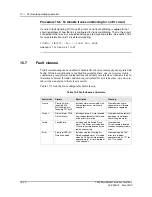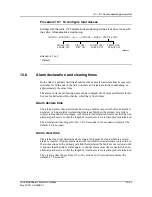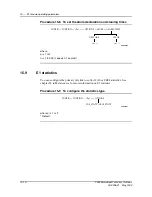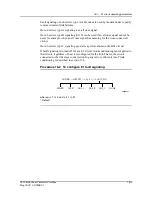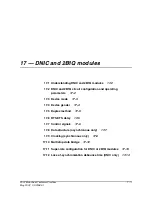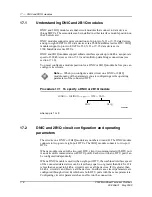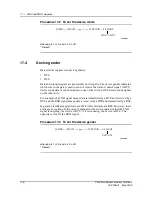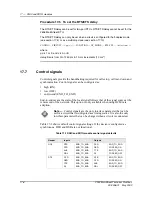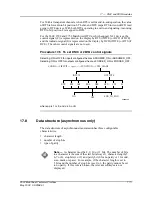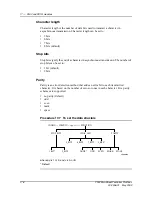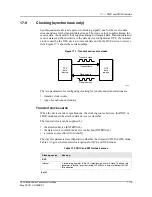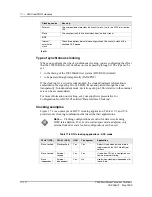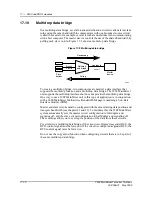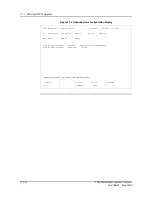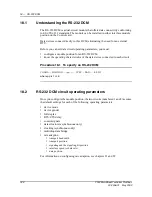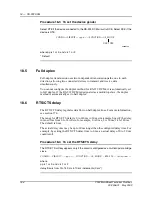
17 — DNIC and 2B1Q modules
2902 MainStreet Technical Practices
17-5
May 2002 90-2906-01
17.5
Duplex method
Data circuits support two duplex modes:
•
half duplex
•
full duplex
Half-duplex transmission uses a single transmission path. Two connected devices
can transmit and receive, but not at the same time. If you select half duplex, the
RTS/CTS delay option can be configured (described in section 17.6).
Full-duplex transmission uses two independent transmission paths, one in each
direction, allowing two connected devices to transmit and receive data
simultaneously.
The duplex method can be set for two-port DTUs. The 2606 MainStreet DTU cannot
be set for half duplex.
Procedure 17-4 To set the duplex method
where
pp
is 1 or 9, and
c
is A or B
* Default
17.6
RTS/CTS delay
RTS and CTS are control signals used to regulate data flow on half-duplex lines.
When one device wants to send a message to a second device, it sends an RTS. After
receiving the RTS, the second device pauses and then returns a CTS. The pause must
be long enough to clear any messages that might be coming into the second device.
The pause is called the RTS/CTS delay.
For example, using the RTS/CTS delay in multidrop data bridge connections makes
a slave device wait long enough to guarantee that a transmission path has been
established to the master device. An RTS/CTS delay that is too short results in
messages being lost on the line. A delay that is too long decreases response time.
The optimum value depends on your network.
The range for RTS/CTS delay is 0 to 1250 ms in 10-ms increments (the default is
10 ms).
HALF_DPLX/FULL_DPLX*
CONFIG — CIRCUIT — <
pp-c
>
↵
— FUNCTION — I/F_MODE
SK000497
Summary of Contents for MainStreet 2902
Page 1: ...2902 MainStreet Network Termination Unit Release 1 0 H T E C H N I C A L P R A C T I C E S ...
Page 40: ...3 Mounting the unit 3 8 2902 MainStreet Technical Practices 90 2906 01 May 2002 ...
Page 50: ...4 Ground and power connections 4 10 2902 MainStreet Technical Practices 90 2906 01 May 2002 ...
Page 68: ...6 Connecting to the network 6 4 2902 MainStreet Technical Practices 90 2906 01 May 2002 ...
Page 90: ...7 Connecting to data devices 7 22 2902 MainStreet Technical Practices 90 2906 01 May 2002 ...
Page 108: ...10 Node management 10 10 2902 MainStreet Technical Practices 90 2906 01 May 2002 ...
Page 150: ...14 CPSS 14 6 2902 MainStreet Technical Practices 90 2906 01 May 2002 ...
Page 218: ...20 Codirectional DCM 20 6 2902 MainStreet Technical Practices 90 2906 01 May 2002 ...
Page 234: ...22 HCM rate adaption 22 10 2902 MainStreet Technical Practices 90 2906 01 May 2002 ...
Page 246: ...23 Cross connecting circuits 23 12 2902 MainStreet Technical Practices 90 2906 01 May 2002 ...
Page 254: ...24 Visual indicators 24 8 2902 MainStreet Technical Practices 90 2906 01 May 2002 ...
Page 266: ...25 Alarms 25 12 2902 MainStreet Technical Practices 90 2906 01 May 2002 ...
Page 278: ...26 System diagnostics 26 12 2902 MainStreet Technical Practices 90 2906 01 May 2002 ...
Page 298: ...27 Loopbacks 27 20 2902 MainStreet Technical Practices 90 2906 01 May 2002 ...
Page 332: ...Glossary GL 8 2902 MainStreet Technical Practices 90 2906 01 May 2002 ...
Page 343: ......
Page 344: ... 2002 Alcatel All rights reserved 90 2906 01 95 1820 01 00 C ...




